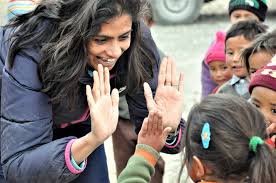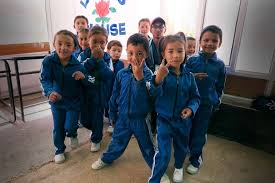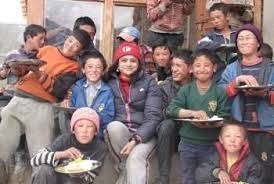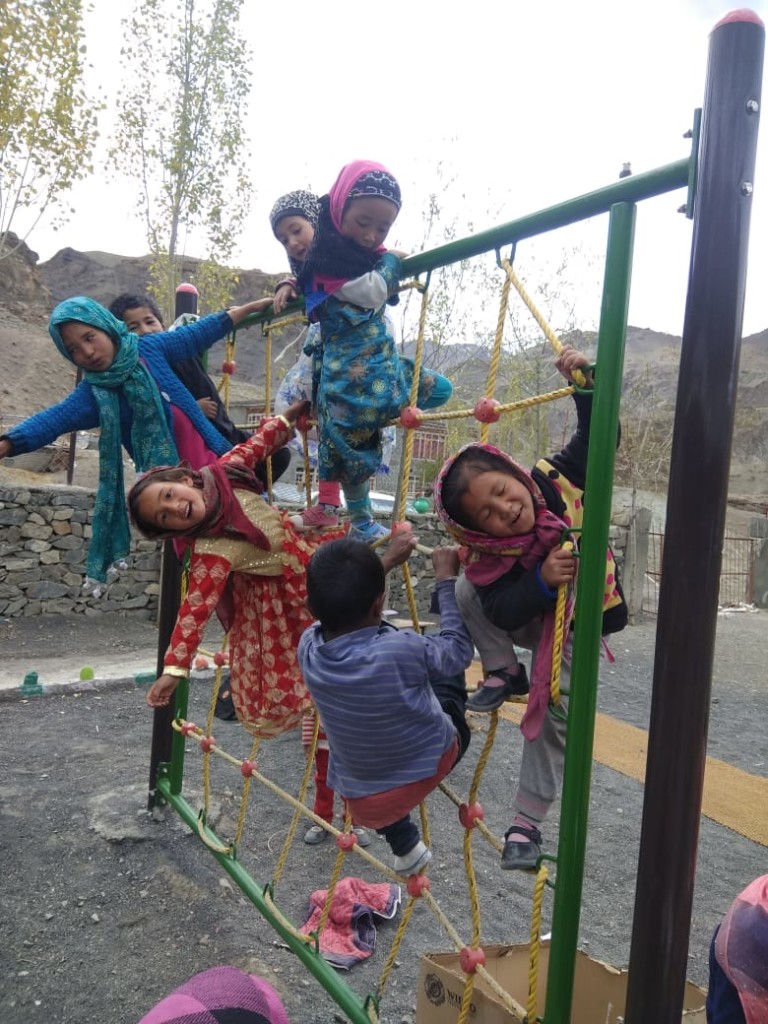From setting up libraries in 230 schools to building playgrounds in 140, Sujata Sahu has been transforming the education scene in rural Ladakh (Kargil and Leh), earning herself the nickname of ‘Iron Lady’.
It was in 2010 that Delhi’s Shri Ram School Maths and Computer Science teacher Sujata Sahu first went on a trip to Ladakh. It was a solo trek, and on the third day, she began to face extreme difficulty breathing and walking. The low oxygen in the altitudes as high as 16,100 feet had given her Pulmonary Edema.
She needed to rest, and with the help of two passing trekkers, she decided to spend the night at a remote village —
“A village which has no road access, is reachable only after a day’s walk, and one which boasted of just one home with three occupants. I had neither medicines, nor the ability to call my family, nor access to medical care,” says 50-year-old Sahu, a resident of Gurugram.
In was in these conditions that she saw two tiny schools which totally changed her life.
The first primary school — Sku-Kaya — had five students and two teachers. It had two rooms which were being rebuilt. While one teacher had stayed in the village, the other had gone to Leh to get uniforms and mid-day meal supplies for the school.
The second school had eight children and three teachers. It was two of them who had stopped to help Sahu when she was feeling sick. They had been walking back to Leh for textbooks and uniforms
The children were being taught from English books, which was very alien to them as they had no electricity or TV or telephone connectivity and thus, had no idea what the outside world was like. Having never set foot out of their villages, the exposure level of these children was very low.
.In Ladakh, even the summer months were bitingly cold but that didn’t stop the kids from coming to school to learn. “One of the children even brought his little brother along, who was barely two years old and the love and care with which all the children and the teacher took care of the child was a lesson for me,” says Sahu.What really hit her on that fateful Ladakh trip was the sheer drive of the Ladakhi people there to keep growing and improving their circumstances.
“Their determination to come to school and learn, the eagerness of the teacher to learn something new to teach his students, and the aspiration of the parents to educate their children was my inspiration to drop everything and help these amazing people,” says Sahu.
From a regular school teacher to Ladakh’s ‘Iron Lady’
“My experience with the schools in Ladakh gave me a path to follow, one that I knew I could contribute to,” says Sujata Sahu, who had spent 12 years in the corporate world before starting to work with children.
But she had been working at the Shri Ram School for just two years at the time, and leaving this job was the hardest decision she had to make in her life.
“I was planning to take on a seemingly herculean task, in possibly one of the toughest terrains of the world. I had no idea about where I would get the funds from and was also not very clear on how much of an impact I alone could make,” she says.
Moreover, no one had done something like this before her in Ladakh. But thankfully, she found with herself two strong founding partners — her husband, Sandeep Sahu, who had been trekking in the region for almost 35 years, and Dawa Jora, a Ladakhi businessman, all of whom had the strong conviction that something like this was really needed for the region.
In 2011, unable to find other NGOs to partner with, the three founders went on a three-day trek to one of the most isolated villages in Lingshed (in Ladakh), carrying 1500 kg of education material on 25 horses, and crossing three mountains at extreme temperatures as low as minus 15 degrees.
The treacherous and steep pass they crossed at an altitude of almost 17000 ft inspired the name of the ‘17000 ft foundation’.
As she started off on her mission to provide Ladakh schools with the right resources to further the education of their students, she realised this wouldn’t be very easy.
“One of our biggest challenges was convincing corporates that even remote areas with extremely scattered and small populations needed support,” says Sahu.
For the first two years, the foundation worked only with the founders’ own funds and kind contributions of friends and family members.
“Though no non-profit organisations were willing to take on Ladakh as a region, we were given support in the form of knowledge, pedagogy and even a large donation of books for our first 100 libraries,” she says.
Sujata Sahu’s undying passion to help the people of Ladakh earned her the nickname of the ‘Iron Lady’.
How Ladakh poses a unique set of education problems
India is a geographical anomaly as it has every type of topographical setup, each of which comes with its own challenges. This makes it extremely difficult for the government to cater to every type of problem that can arise in this vast country owing to accessibility issues, extreme weather conditions etc.
Ladakh has almost a 1000 schools across Leh and Kargil, spread across 60,000 sq km of harsh mountains. Catering to a school going population of under 40,000 children, the average school strength of these schools is barely 25 students across the two districts, explains Sahu.
Teachers themselves come from remote villages and have to travel long distances for training, school supplies and even basic administrative functions, leading to long absences and shortage of staff, she adds.
Also, “While teachers are given basic residential training during winters as well as in-service training, most of the trainings are not contextualized for the uniqueness of the Ladakhi education system,” she says.
The extreme weather also adds to the problems with schools being shut for severe winters for three months in a year when the roads become inaccessible due to thick snow and temperatures as low as minus 35-40 degrees.
“Incredibly, despite the remoteness of the region, every little hamlet which has even 10 school going children has a tiny government school with teachers in attendance, thanks to the local administration. A little wonder then, that 89% of the schools in Ladakh are govt schools with the private schools present in just a handful of the larger villages,” she says.
“What is commendable is that all these 900 plus schools are functional and have qualified teachers in attendance. What is even more remarkable is that every child in every village goes to school, managing to at least complete middle school,” Sahu adds
However, it is only the larger villages which have middle schools and after passing class 5, children have to walk around two hours to get to school to continue their education. Public transport isn’t available in such terrain and the army provides army vans for commuting.
.Despite the presence of these govt schools, the community here wants a better life and quality education for their children so they can get better jobs. This aspiration makes them send their very young children, often as young as three years old, to be enrolled in private schools, often extremely far away from their homes.
“Cut off from their villages and parents for months in a year, these children grow up in dormitories, hostels or with other families. Lacking the care and guidance they need in their growing up years, this leads to large-scale dropouts and a population of youth who are unable to go back to their villages,” Sahu explains.
17000 ft works in these remote villages by improving existing govt schools so that parents would have faith in them and stop sending their children away so far that it disconnects them from their roots.
How voluntourism is helping 17000 ft foundation grow
Sujata Sahu started her non-profit organisation with just the founders and a few volunteers who were given the task to survey the entire length and breadth of Ladakh.
The team mapped around 600 schools after a seven-month-long study. Some of these schools had been bomb shelters during the Kargil war and the buildings had to be shifted multiple times.
The success of the volunteer programmes helped the foundation grow and each of these schools has been geo-mapped for travellers to find.
“We, very early on, piloted our volunteering programmes to involve outsiders in the work of our organization and to also understand if people could be encouraged to donate to such a cause. The enthusiasm and support shown by complete strangers told us that we were on the right track,” says Sahu.
“Our volunteers, who are our brand ambassadors, then carried the story of our work into their workplaces and CSR then became our main source of funding. Voluntourism, as it is called today, still forms a good 25% of our annual budget and helps us maintain our backend costs,” she adds.
Why playgrounds are so important in Ladakh schools
Though the govt schools all over Ladakh have proper buildings, they lack the proper facilities that make a school a happy, joyous and welcoming place for children. And in a remote location with rugged ground, a playground comes as a blessing.
“In these remote villages, where nothing is available, there are absolutely no options for children to play with. Though these schools have well-qualified teachers and very low pupil-teacher-ratio, parents often judge the performance of a school based just on the facilities they provide,” says Sahu.
Thus, parents see the existence of a playground in govt schools as a very good incentive to not send away their kids to far-off private schools.
“Today, 17000 ft foundation has setup playgrounds in 140 schools with colourful swings, slides, see saws etc. many of which the team had to carry over horseback for days to reach our remotest schools,” she says.
Solving the problem of no native language storybooks in Ladakh
A big aspect of Ladakh education that surprised Sujata Sahu was how the kids learned in English medium schools even though they have no exposure to the foreign language. Their native language was Bhoti.
“To add to this burden, children also have to study their local language as well an additional Hindi/Urdu from grade 1,” says Sahu.
To enable the children to read better and get comfortable with the number of languages they have to deal with, 17000 ft set up libraries in 230 schools with simple and easy to read story books in English, Hindi and Urdu.
“However, sadly, there are absolutely no story books in Bhoti for children to read. Sensing this gap, we undertook a mission to translate storybooks from English to Bhoti.”
“In 2015, we launched our first phase where we translated 21 titles and published 21,000 storybooks for distribution into 300 schools,” says Sahu.
This year again, the organisation not only translated another 20 titles, but also added illustrations and changed narratives to make them more relatable to the children of Ladakh.
What has 17000 ft foundation achieved so far?
In the span of just six years, Sujata Sahu’s organisation has accomplished much.
“Today, 17000 ft works with 250 govt schools across Leh and Kargil and we are already seeing a reverse trend of children coming back from private schools back to the govt schools in their villages,” says Sahu.
The organisation has set up libraries in 230 schools, playgrounds in 140 schools, and trained over 1500 teachers in various methodologies with a team which is in Ladakh every winter for training teachers.
17000 ft foundation has conducted multiple community workshops in 125 villages with over 10,000 villagers contributing to our workshops and programmes in the schools.
Recently, the organisation electrified and digitized 120 schools in Leh and Kargil, providing solar electricity and tablets with customized digital learning content, a TV, and a server to provide offline data syncing.
The DigiLab project is the non-profit’s most ambitious programme bringing offline hybrid digital learning solutions to the remote villages.
The well-furnished digital labs supported by workshops from the team throughout the year can help the students learn independently with guidance from their teachers.
How crowfunding is helping 17000 ft foundation
Crowdfunding is increasingly coming up as a very important resource collection measure.
“17000 ft has been involved with ImpactGuru.com in multiple projects, the latest being the funding of a Playground for a very remote school in Kargil. We had also fundraised for our Bhoti Book Translation project through ImpactGuru.com and managed to raise more than we needed,” says Sahu.
Fundraising platforms are great for helping nonprofits fund small projects that have tangible goals and timelines. It is an excellent way to help get the word out to potential supporters and garner more support for the non-profit, says the Iron Lady of Ladakh.
Future of 17000 ft foundation
Before 17000 ft was established, there was little or no attention on the remote schools of Ladakh, and today with all our work and efforts and the participation of the local communities, govt schools are looking and performing better and we are seeing a reverse trend of children coming back to their villages and govt schools.
“When we started, one of our biggest challenges was encouraging donors, volunteers, foundations and even corporates to focus on remote regions of Ladakh. Today, however, we are confident that our model is working and we can get the support we need,” beams Sahu.
Sujata Sahu now wants to take this model to other remote and mountainous regions, like Arunachal Pradesh, or the remote areas of Himachal.
“We feel that we are closer now to our vision of a better life and education for all children, regardless of geography or terrain,” she says.
Article Credit: IndiaToday




